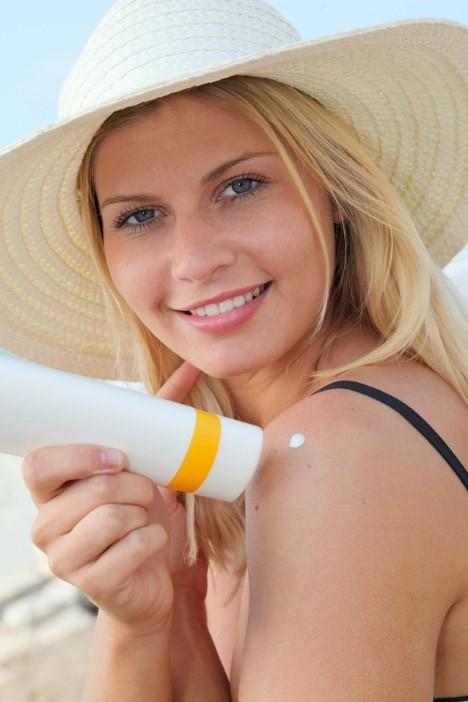I’m sure you’ve noticed that in the world of advertising, sex sells. Victoria’s Secret ads are a perfect example—it’s easy to sell a bunch of grossly overpriced bras by showing the “angels” modeling them.
Knows what else sells?
Fear!
And when it comes to sunscreens, fear of skin cancer is the golden ticket.
But I have a few questions here and you should too:
- Is the sun truly the evil, skin-cancer-creating monster it’s been made out to be by people that make boatloads of money on that perception?
- And are sunscreens safe and effective?
Let’s take a look and see…
History speaks for itself
Sunscreen was first brought to market in 1936, introduced by French chemist Eugène Schueller—the founder of L'Oreal cosmetics.
So it only follows that prior to 1936, people must have been keeling over in massive numbers from skin cancer, right?
Not exactly.
And what’s even more concerning is the fact that even though we are using more sunscreen than ever before in our existence, our rates of skin cancer still continue to rise!
Clearly something is not adding up here.
It’s not cut and dry
The whole skin cancer issue is not cut and dry, and many people are misinformed about a number of things.
First of all, there are three types of skin cancer—basal cell carcinoma and squamous cell carcinoma (which are rarely fatal) and melanoma (which is the deadliest). Most skin cancer cases involve basal and squamous cell carcinomas.
Basal and squamous cell cancers are strongly related to UV exposure over a period of years. Studies have shown that some sunscreens may help lower the risk of squamous cell carcinoma, but not necessarily basal cell carcinoma.
Melanoma, on the other hand, is associated with sunburn, especially sunburns you get early in life. But interestingly, melanoma often appears on areas of the body that rarely are exposed to the sun—so even this puzzle is missing a few pieces.
Plus studies have not conclusively determined that sunscreen protects you against melanoma! Some studies suggest a positive outcome, some show no difference, and even others have shown an increased risk of melanoma with suncreen use!
The dark side of shunning the sun
Shunning the sun does have a dark side (no pun intended)—because your body needs UV light exposure from the sun to make vitamin D.
Vitamin D protects you against cancer, so by avoiding the sun because you’re scared of skin cancer, you’re actually in effect raising your overall risk of cancer!
Plus vitamin D is crucial for bone health, a strong-functioning immune system and a healthy cardiovascular system, among other things.
All sunscreens are not created equal
This is arguably the most important point of all. Many sunscreens are not only not completely bloody effective, but up to 75 percent of them are downright toxic!
First of all, a product needs to shield you from both UVA and UVB radiation, as both of these can increase your skin cancer risk with overexposure. But many sunscreens only protect against UVB rays, which are the rays that your body uses to make vitamin D.
So you’re getting only half the protection yet at the same time are shutting down your body’s vitamin D production!
The FDA is currently proposing new regulations regarding the safety of sunscreen ingredients, but who knows how quickly that will come to fruition…or how effective the sunscreen industry will be in lobbying to protect their cash cows.
But generally speaking, the following sunscreen ingredients have either been shown to be toxic, or at a minimum data supporting their safety are lacking:
- Para amino benzoic acid (PABA)
- Octyl salicyclate
- Oxybenzone (Found in about 70 percent of sunscreens, research suggests oxybenzone is an endocrine disruptor, and it has been linked to reduced sperm count in men and endometriosis in women. Plus it is known to harm coral reefs and aquatic life.)
- Cinoxate
- Dioxybenzone
- Phenylbenzimidazole
- Homosalate
- Menthyl anthranilate
- Octocrylene
- Methoxycinnamate
- Parabens
On the other hand, out of all the active sunscreen ingredients widely used in products in the US, only two — non-nano-sized zinc oxide and titanium dioxide — have been deemed safe for human use by the FDA.
A smarter approach
Clearly, completely shunning the sun is not necessarily in your best interest, nor is slathering potentially toxic sunscreen on your skin or thinking you have free reign to roast yourself like a turkey because you have sunscreen on!
Here is a smart approach to getting healthier sun exposure and still protecting yourself:
Take care of your skin from the inside out!
Skin health starts on this inside, and that means eating lots of fresh fruits and vegetables, drinking plenty of water and getting enough Omega-3 essential fatty acids.
A pure fish oil formula like VitalMega-3 can help ensure you have healthy-skin-supporting levels of these crucial nutrients, especially since most people don’t eat nearly enough fish to give their bodies the Omega-3 EFAs they need!
Also important for skin health are antioxidants, biotin, vitamin B6 and vitamins C and E.
Super Core multi-vitamin and mineral formula contains healthful doses of all these nutrients, plus natural antioxidants which help counteract premature aging from free radicals, and anti-inflammatories which support skin health!
Get 20-30 minutes of unprotected sun exposure each day
This will help allow your skin to naturally produce vitamin D as it was designed to.
Plus the sun’s rays have been shown to have a positive effect on skin conditions such as psoriasis, acne and eczema, and sunlight helps to kill harmful bacteria on your skin.
In addition, sunlight also builds your immune system. Your immune system’s white blood cells (lymphocytes) increase with sun exposure, and these cells play a major role in defending your body against infections.
Protect for longer exposure
If you stay in the sun for longer than 30 minutes, it’s time to protect yourself. Options include wearing light clothing, sitting under an umbrella, or wearing a wide-brimmed hat and sunglasses.
As far as sunscreens go, be sure to choose “broad protection” (UVA and UVB) mineral-based varieties that do not contain the harmful ingredients listed above. I use Badger, but there are many great brands out there including Bare Republic, Burt’s Bees, Neutrogena and Laguna Herbals. The Environmental Working Group (EWG) has an extensive list of safe sunscreens on their site.
Never, EVER get a sunburn
If you see your skin going from light pink or tan to red, get out of the sun immediately and put some aloe vera and/or vitamin E gel on your skin.
Enjoy the sun the way you’re supposed to—safely and healthfully!
To your health,
Sherry Brescia
The information in our articles are NOT intended to replace a one-on-one relationship with a qualified health care professional and are not intended as medical advice.











